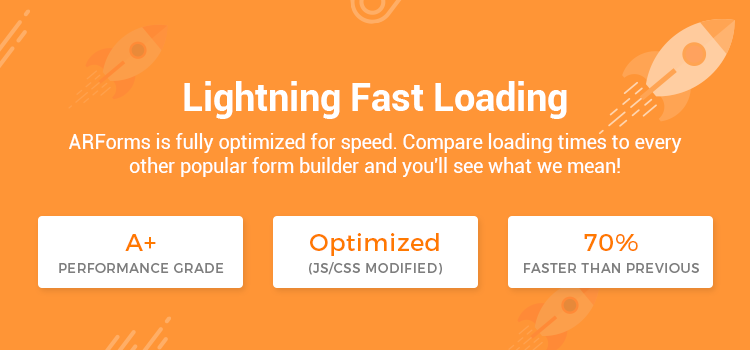WordPress Contact Form Plugin Optimized for Better Performance
Do you know that many people tend to abandon the website if it’s not loaded in at least 5 seconds? What can that mean for you? Being totally honest, a slow website is a killer for your business. It steals your visitors, thus, prospective customers.
User’s dissatisfaction causes a higher website bounce rates (you won’t be happy to see those in your Google Analytics), fewer views from mobile devices (if you remember, “mobile first” index is Google’s primary thing for 2018), and eventually, search engines start giving your website less ranking value.
On the other hand, decreasing a page load time won’t only ensure a better user experience and better SEO rankings, but may drastically increase conversions if you sell products or services on your website. Will I stress that enough saying that you should be totally obsessed with the website speed?
In the WordPress space, many things can cause performance issues. Bloated plugins are among of them.
In this post, we’ll be talking particularly about WordPress contact form builders that are used on almost any website, are directly connected with the client interaction, therefore, should be treated with a special attention.
So, do you want buggy, poorly optimized plugins to host your WordPress contact form and destroy your website performance? Unlikely.
But you might be surprised that while lots of contact form plugins in WordPress already offer dozens of tools, they may not really take care of performance.
Customers, blinded by a long list of features, may simply be not aware that performance is just as important. However, as we’ve already said, website performance is everything – it’s your SEO rankings, user experience, conversions and overall website sustainability. Unfortunately, bloated plugins still thrive causing many issues.
The vast majority of WordPress contact form plugins are built with shortcodes. Shortcode parsing is a very processor-intensive process, especially if we are talking about complex layouts and complicated styles, it can really take a lot of time to paint them in your browser. Bloated plugins make the process even worse.
Let’s have a quick look under the hood! Would you bear with the lingo for a moment?
Many WordPress contact form plugins sin by heavily using JavaScript and CSS files (those things that turn the code behind into a normal website page). This results in an increased number of HTTP requests affecting the performance of your WordPress website. But the chief problem here is that many WordPress contact form (and not only) providers make the plugin shortcode load on non-essential website pages of the WordPress website instead of just one. And this is one of the main sources of the performance issues.
Simply put, when the plugin uses too many external resources to load your content via shortcode, it significantly slows down the website, negatively affecting a website load speed, bringing more frustration to the website visitors.
So, if you want to make a positive difference to your website, you should improve the system of rendering CSS and JavaScript files. Or at least use those tools that are good enough to do that for free.
Sticking to such a mature product like ARForms WordPress form builder plugin, you do a favor to your website because:
Too many things on the WordPress website are predominantly determined by the quality of the plugins you use. WordPress contact form, as the main middleman for all your client interactions, should be really lightweight and optimized for better website performance.
When your contact form plugin includes JavaScript and CSS files on each and every website page instead of loading them only on the page whether the shortcode is placed, you should really do something about it.
Basically, there are two ways – either improve it manually or get the WordPress contact form builder plugin that is built for better performance out of the box. This way you can have an array of contact forms that won’t destroy your website performance and won’t screw up your SEO ranking.
User’s dissatisfaction causes a higher website bounce rates (you won’t be happy to see those in your Google Analytics), fewer views from mobile devices (if you remember, “mobile first” index is Google’s primary thing for 2018), and eventually, search engines start giving your website less ranking value.
On the other hand, decreasing a page load time won’t only ensure a better user experience and better SEO rankings, but may drastically increase conversions if you sell products or services on your website. Will I stress that enough saying that you should be totally obsessed with the website speed?
In the WordPress space, many things can cause performance issues. Bloated plugins are among of them.
In this post, we’ll be talking particularly about WordPress contact form builders that are used on almost any website, are directly connected with the client interaction, therefore, should be treated with a special attention.
So, do you want buggy, poorly optimized plugins to host your WordPress contact form and destroy your website performance? Unlikely.
But you might be surprised that while lots of contact form plugins in WordPress already offer dozens of tools, they may not really take care of performance.
Customers, blinded by a long list of features, may simply be not aware that performance is just as important. However, as we’ve already said, website performance is everything – it’s your SEO rankings, user experience, conversions and overall website sustainability. Unfortunately, bloated plugins still thrive causing many issues.
What’s the problem with many WordPress contact form?
The vast majority of WordPress contact form plugins are built with shortcodes. Shortcode parsing is a very processor-intensive process, especially if we are talking about complex layouts and complicated styles, it can really take a lot of time to paint them in your browser. Bloated plugins make the process even worse.
Let’s have a quick look under the hood! Would you bear with the lingo for a moment?
Many WordPress contact form plugins sin by heavily using JavaScript and CSS files (those things that turn the code behind into a normal website page). This results in an increased number of HTTP requests affecting the performance of your WordPress website. But the chief problem here is that many WordPress contact form (and not only) providers make the plugin shortcode load on non-essential website pages of the WordPress website instead of just one. And this is one of the main sources of the performance issues.
Simply put, when the plugin uses too many external resources to load your content via shortcode, it significantly slows down the website, negatively affecting a website load speed, bringing more frustration to the website visitors.
So, if you want to make a positive difference to your website, you should improve the system of rendering CSS and JavaScript files. Or at least use those tools that are good enough to do that for free.
Use ARForms plugin to lighten the source code and load the pages faster
Sticking to such a mature product like ARForms WordPress form builder plugin, you do a favor to your website because:
- JavaScript / CSS resources of ARForms are already minified, so the plugin is ready to significantly improve your website speed or at least not harm it. And it doesn’t cost you any effort.
- Unlike other contact form solutions, ARForms loads JavaScript / CSS without additional processing on non-essential website pages. That is, it will much faster load the shortcode-generated content only on one page, reducing the number of requests and improving your website performance. Again, no efforts on your side.
- No need to integrate third-party resources or hiring tech people. ARForms is decent enough to provide you with a solid lightweight functionality by default.
Summing up on WordPress contact forms performance
Too many things on the WordPress website are predominantly determined by the quality of the plugins you use. WordPress contact form, as the main middleman for all your client interactions, should be really lightweight and optimized for better website performance.
When your contact form plugin includes JavaScript and CSS files on each and every website page instead of loading them only on the page whether the shortcode is placed, you should really do something about it.
Basically, there are two ways – either improve it manually or get the WordPress contact form builder plugin that is built for better performance out of the box. This way you can have an array of contact forms that won’t destroy your website performance and won’t screw up your SEO ranking.



